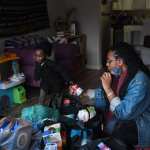The unemployment rate for Black women fell from 7 percent to 5 percent in November, a large drop after months of lackluster growth, according to data released by the Bureau of Labor Statistics Friday.
Typically, unemployment rates change very little from month to month, so the drop among Black women, who have consistently had some of the highest rates of any racial group, is significant. However, since the pandemic began, monthly jobs figures have been more volatile, and clear explanations of what is happening in the labor market have become even more rare.
“I don’t think we can celebrate quite yet,” said Elise Gould, senior economist at the Economic Policy Institute, a left-leaning think tank. “I’m hopeful this means recovery is finally reaching them. I would like to believe it holds … I’m also really cautious because this data comes with a lot of volatility.”
It appears that the reason for the drop is mixed: Unemployment rates can fall because people leave the labor force, a “bad” reason because it means the rate is lower as a result of the overall labor force being smaller. To be counted as out of the labor force, people have to be unemployed and not looking for work at all. About 91,000 Black women left the labor force last month, the biggest month-to-month drop this year. But, their employment-to-population ratio — a figure that measures the number of people employed compared to the working-age population — went up.
“That drop in unemployment is in part because people are getting jobs, but also in part because people are leaving the labor force,” Gould said.
It’s difficult to say for sure after just one month, she said, because BLS has suspended in-person surveys during the pandemic. That has made it harder to reach people and exacerbated challenges for data collection of smaller cross sections of populations, particularly Black and Latinx women who have been hit hard by the pandemic and may not be responding to surveys in the way they did in the past. (BLS does not collect data on nonbinary people.)
When small sample sizes are smaller, it’s more difficult to draw conclusions about what is happening each month.
The story for Black women may not be clear until the coming months, when there is more data available to track if unemployment rates are really dropping.
Angela Hanks, the acting assistant secretary and principal deputy assistant secretary of the Employment and Training Administration at the Department of Labor, said what may turn the tide for Black women is increased vaccinations and the return of jobs in fields like child care.
Black women are overrepresented in jobs that deal directly with people, like hospitality and nursing. The child care crisis also makes it challenging for women to return to work. Since September, job growth in the child care sector has remained flat.
“We’re still in a pandemic where Black women were disproportionately impacted. Increasing vaccinations only makes Black women more safe and more confident that the workplaces that they’re going into will keep them and their families safe and healthy,” Hanks said.
The president’s Build Back Better package, which is likely being negotiated in the Senate this month, includes investments to increase the supply of child care, bring down the cost for parents and raise wages for child care workers to be more on par with teachers. Black women make up 16 percent of all child care workers.
In the meantime, Hanks said the Department of Labor is looking at ways it can focus on equity in areas like grant making. The department has been adding requirements into grants for apprenticeships, for example, such as additional funds to expand recruiting and attract diverse candidates.
“We want to make sure that it actually supports the communities that are going through it and so it’s not just access, it also is: What are the supportive and comprehensive services that we can provide?” Hanks said. “And so if you start from that place of, ‘What are the specific barriers that people face?’ and then develop policy around that, you will actually sort of meet people where they are.”
Those are all part of a longer term strategy with the goal of closing the gap between unemployment rates for communities of color and White Americans.
In November, unemployment rates for Black women and Latinas (5.3 percent) remained higher than those for White women, whose unemployment rate is now 3.7 percent, about what it was when the pandemic began. Asian women’s rate, which is not adjusted for seasonal hiring like the other figures, is also down at 3.9 percent.
Overall, about 320,000 men rejoined the workforce last month, compared to 274,000 women.
Based on a survey of employers, the economy added 210,000 net jobs in November — far below projections that estimated an addition of about half a million new jobs, even when taking into account that the figures will likely be readjusted next month when BLS revises the numbers. BLS figures are estimates, and they undergo several revisions, which are published the month after the initial release. Almost every month this year, the revisions have caused the monthly figures to go up slightly from the original estimates.
About 64 percent of the net gains in November went to men, who saw an increase in 134,000 net jobs. For women, it was 76,000 net jobs. Likely driving that is strong growth in industries dominated by men, including professional and business services, which added 90,000 jobs; transportation and warehousing, which added 50,000 jobs; and construction, which saw an increase of 31,000 jobs.
Fields dominated by women, including retail, hospitality and health care, were all essentially flat over the past month. Hospitality was the most severely hurt by the pandemic, which wiped out half of all its positions in April 2020. Typically, hospitality has been a bellwether for strong employment months for women — when hospitality jobs return, women also return to the labor force. That was not the case this month.
According to Gould, at this pace, it will take until the end of 2022 to return to pre-pandemic levels.






